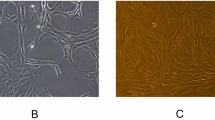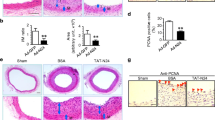Abstract
Tissue kallikrein 1 cleaves kininogen substrate to produce vasoactive kinin peptides that have been implicated in inhibiting neointimal hyperplasia in rat carotid arteries after balloon injury. However, its effects on the proliferation, cell cycle and its mechanisms, for example, cyclin-dependent kinase inhibitors, p27Kip1 and p2lCip1 in vascular biology are poorly understood. The objective of this study was to explore the effects of human tissue kallikrein 1 (hTK1) mediated by recombinant adenovirus (Ad-hTK1) on proliferation and cell cycle of vascular smooth muscle cells (VSMCs) derived from spontaneously hypertensive rats induced by platelet-derived growth factor-BB (PDGF-BB) in vitro. The results showed that, within a given multiplicity of infection (MOI) and time, the hTK1 gene delivery inhibited PDGF-BB-stimulating VSMCs growth in a concentration-dependent (20–100 MOI) and time-dependent (2–5 days) manner by cell counting, with a peak inhibition rate at 36.3% at 72 h (P < 0.01). In addition, hTK1 gene delivery significantly suppressed PDGF-BB-induced proliferation of VSMCs by methyl thiazolyl tetrazoliuin assay, and decreased the percentage of cells in the S phase and in DNA synthesis by flow cytometry, with a peak inhibition rate at 30.2 and 36.4%, respectively (P < 0.01). Western blot assay showed that the protein levels of p27Kip1 and p2lCip1 in cells infected with Ad-hTK1 were much more abundant than those in cells only induced by PDGF-BB, with up-modulating rates at 51.8 and 58.7%, respectively (P < 0.001). We also observed that the effects of hTK1 gene delivery in inhibiting VSMCs proliferation, arresting cell cycling in G0/G1 phase and up-regulating the expression of p27Kip1 and p2lCip1 could be blocked by icatibant (Hoe 140), a specific bradykinin B2 receptor antagonist. Taken together, these results demonstrated that hTK1 overexpressed by recombinant adenovirus potently inhibits VSMCs proliferation that is required for neointimal hyperplasia and restenosis, and may activate p27Kip1 and p2lCip1 signaling pathways via bradykinin B2 receptor.




Similar content being viewed by others
References
Ross R (1993) The pathogenesis of atherosclerosis: a perspective for the 1990s. Nature 362(6423):801–809
Braun-Dullaeus RC, Mann MJ, Dzau VJ et al (1998) Cell cycle progression: new therapeutic target for vascular proliferative disease. Circulation 98(1):82–89
Toyoshima H, Hunter T (1994) p27, a novel inhibitor of G1 cyclin-Cdk protein kinase activity, is related to p21. Cell 78(1):67–74
Maddika S, Ande SR, Panigrahi S et al (2007) Cell survival, cell death and cell cycle pathways are interconnected: implications for cancer therapy. Drug Resist Update 10(1–2):13–29
Tanner FC, Boehm M, Akyürek LM et al (2000) Differential effects of the cyclin-dependent kinase inhibitors p27 (Kip1), p21 (Cip1), and p16 (Ink4) on vascular smooth muscle cell proliferation. Circulation 101(17):2022–2025
Bhoola KD, Figueroa CD, Worthy K (1992) Bioregulation of kinins: kallikreins, kininogens, and kininases. Pharmacol Rev 44(1):1–8
Silva JA Jr, Araujo RC, Baltatu O et al (2000) Reduced cardiac hypertrophy and altered blood pressure control in transgenic rats with the human tissue kallikrein gene. FASEB J14(13):1858–1860
Yin H, Chao L, Chao J (2008) Nitric oxide mediates cardiac protection of tissue kallikrein by reducing inflammation and ventricular remodeling after myocardial ischemia/reperfusion. Life Sci 82(3–4):156–165
Hagiwara M, Shen B, Chao L et al (2008) Kallikrein modified mesenchymal stem cell implantation provides enhanced protection against acute ischemic kidney injury by inhibiting apoptosis and inflammation. Hum Gene Ther 19(8):807–819
Xia C, Yin H, Yao Y et al (2006) Kallikrein protects against ischemic stroke by inhibiting apoptosis and inflammation and promoting angiogenesis and neurogenesis. Hum Gene Ther 17(2):206–219
Gao L, Yin H, Smith S, Jr R et al (2008) Role of kallistatin in prevention of cardiac remodeling after chronic myocardial infarction. Lab Invest 88(11):1157–1166
Emanueli C, Zacheo A, Minasi A et al (2000) Adenovirus-mediated human tissue kallikrein gene delivery induces angiogenesis in normoperfused skeletal muscle. Arterioscler Thromb Vasc Biol 20(11):2379–2385
Murakami H, Yayama K, Miao RQ et al (1999) Kallikrein gene delivery inhibits vascular smooth muscle cell growth and neointima formation in the rat artery after balloon angioplasty. Hypertension 34(2):164–170
Murakami H, Miao RQ, Chao L et al (1999) Adenovirus-mediated kallikrein gene transfer inhibits neointima formation via increased production of nitric oxide in rat artery. Immunopharmacology 44(1–2):137–143
Yu HZ, Xie LD, Zhu PL et al (2008) Construction of bicistronic recombinant adenovirus vector for hKLK1 gene and its expression on vascular smooth muscle cells from SHR. Chin J Pathophysiol 24(2):411–416
Su FM, Li TY, Liu ZH et al (2006) Effects of gene delivery of human tissue kallikrein into hypertensive rats. Chin J Lab Diagn 10(11):1252–1254
Chen HF, Xie LD, Xu CS (2010) The signal transduction pathways of heat shock protein 27 phosphorylation in vascular smooth muscle cells. Mol Cell Biochem 333(1–2):49–56
Hur KY, Seo HJ, Kang ES et al (2008) Therapeutic effect of magnesium lithospermate B on neointimal formation after balloon-induced vascular injury. Eur J Pharmacol 586(1–3):226–233
Chao J, Shen B, Gao L et al (2010) Tissue kallikrein in cardiovascular, cerebrovascular and renal diseases and skin wound healing. Biol Chem 391(4):345–355
Dix BS, Evanoff D, Fang WB et al (2002) Bradykinin B1 receptor blocks PDGF-induced mitogenesis by prolonging ERK activation and increasing p27Kip1. Am J Physiol Cell Physiol 283(1):C193–C203
Miao RQ, Murakami H, Song Q et al (2000) Kallistatin stimulates vascular smooth muscle cell proliferation and migration in vitro and neointima formation in balloon-injured rat artery. Circ Res 86(4):418–424
Okamoto K, Aoki K (1963) Development of a strain of spontaneously hypertensive rats. Jpn Circ J 27(3):282–293
Johns DG, Webb RC, Charpie JR (2001) Impaired ceramide signaling in spontaneously hypertensive rat vascular smooth muscle: a possible mechanism for augmented cell proliferation. J Hypertens 19(1):63–70
Agata J, Miao RQ, Yayama KS et al (2000) Bradykinin B1 receptor mediates inhibition of neointima formation in rat artery after balloon angioplasty. Hypertension 36(3):364–370
Chao J, Chai KX, Chen LM et al (1990) Tissue kallikrein-binding protein is a serpin, I: purification, characterization, and distribution in normotensive and spontaneously hypertensive rats. J Biol Chem 265(27):16394–16401
Tanner FC, Yang ZY, Duckers E et al (1998) Expression of cyclin-dependent kinase inhibitors in vascular disease. Circ Res 82(3):396–403
Hunter T (1993) Braking the cycle. Cell 75(5):839–841
Condorelli G, Aycock J, Frati G et al (2001) Mutated p21/WAF/CIP transgene overexpression reduces smooth muscle cell proliferation, macrophage deposition, oxidation-sensitive mechanisms, and restenosis in hypercholesterolemic apolipoprotein E knockout mice. FASEB J 15(12):2162–2170
Tanner F, Boehm M, Akyürek L et al (2000) Differential effects of the cyclin-dependent kinase inhibitors p27Kip1, p21Cip1, and p16Ink4 on vascular smooth muscle cell proliferation. Circulation 101(17):2022–2025
Braun-Dullaeus RC, Mann MJ, Ziegler A et al (1999) A role for the cyclin-dependent kinase inhibitor p27(Kip1) in angiotensin II-stimulated vascular smooth muscle cell hypertrophy. J Clin Invest 104(6):815–823
Bledsoe G, Shen B, Yao Y et al (2008) Role of tissue kallikrein in the prevention and recovery of gentamicin-induced renal injury. Toxicol Sci 102(2):433–443
Li H, Yin H, Yao Y et al (2007) Tissue kallikrein protects against pressure overload-induced cardiac hypertrophy though kinin B2 receptor and glycogen synthase kinase-3 activation. Cardiovasc Res 73(1):130–142
Dixon BS, Breckon R, Fortune J et al (1990) Effects of kinins on cultured arterial smooth muscle. Am J Physiol 258(2pt1):C299–C308
Graves LM, Bornfeldt KE, Raines EW et al (1993) Protein kinase A antagonizes platelet-derived growth factor induced signaling by mitogen-activated protein kinase in human arterial smooth muscle cells. Proc Natl Acad Sci USA 90(21):10300–10304
Kato J, Matsuoka M, Polyak K et al (1994) Cyclic AMP induced G1 phase arrest mediated by an inhibitor (p27Kip1) of cyclin dependent kinase 4 activation. Cell 79(3):487–496
Acknowledgments
This study was supported by grants from Fujian Natured Science Foundation (2008J0082), Key projects of Fujian provincial Science and technology (2008KJB-02), and The Key program from Bureau of Scientific Research of Fujian Medical University (09ZD005).
Author information
Authors and Affiliations
Corresponding authors
Rights and permissions
About this article
Cite this article
Yu, HZ., Xie, Ld., Zhu, Pl. et al. Human tissue kallikrein 1 gene delivery inhibits PDGF-BB-induced vascular smooth muscle cells proliferation and upregulates the expressions of p27Kip1 and p2lCip1 . Mol Cell Biochem 360, 363–371 (2012). https://doi.org/10.1007/s11010-011-1076-y
Received:
Accepted:
Published:
Issue Date:
DOI: https://doi.org/10.1007/s11010-011-1076-y




